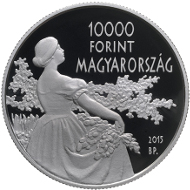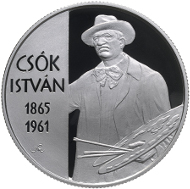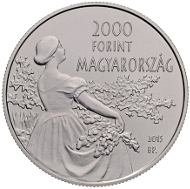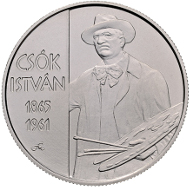April 2, 2015 – The Magyar Nemzeti Bank honours the great Hungarian painter István Csók with the issuance of a commemorative coin marking the 150th anniversary of his birth.
Hungary / 2015 / 10,000 forint / Ag .925 / 37 mm / 24 g / Design: Mihály Fritz / Mintage: 5,000.
The coin was designed by the sculptor Mihály Fritz and features a symbolic detail of Csók’s painting Spring Awakening from 1900, depicting a woman holding flowers in her lap, a harbinger of a new and better life. A portrait of the painter can be found on the reverse side of the coin, inspired by one of Csók’s most popular works Studio Interior from 1905. A 10,000-forint silver version and a 2,000-forint copper alloy version of the coin are being issued.
István Csók (1865-1961)
Born to wealthy mill-owner Lajos Csók on 13 February 1865 in the village of Sáregres in Fejér Comitat, István Csók – known as the “painter of life’s joy” – is considered one of the greatest figures of Hungarian painting. His talent came to the fore at an early age: he was attending 5th grade at an elementary school in Buda when he completed his first oil painting. Similar to many of his peers, he started his studies at the Budapest Drawing School, after which he studied at the Academy of Fine Arts in Munich and then at the Julian Academy in Paris. As he himself said, his painting always evolved between the forces of tradition and innovation, as he steadily moved away from the systematic rigor of the academy style towards a more free, expressionist approach.
Hungary / 2015 / 2,000 forint / CuNi / 37 mm / 23,7 g / Design: Mihály Fritz / Mintage: 5,000.
His first publicly exhibited work was Potato Peelers at the 1889 Paris World Exhibition, which won honourable mention. Around the turn of the century, he established his reputation with his naturalist paintings of country life. He participated in numerous exhibitions (including Paris, Munich, Vienna, Warsaw, Amsterdam, Dresden, Budapest), where his works frequently won awards and was a regular exhibitor at the Venice Biennial. As a sign of his international significance, the Uffizi Gallery in Florence asked him to paint a self-portrait for its own collection. His career reached its peak in 1914, with a retrospective exhibition at the Budapest Palace of Art, where the public was treated to 140 of his paintings, including all of his major works. In 1950 and 1955, the Museum of Fine Arts held exhibitions of his life’s work, and a street and gallery in Székesfehérvár are named after him.
He held the post of rector at the College of Fine Arts in the 1920s and was a member of the Szinyei Merse Pál Association. He was elected a member of several art associations during his life (MIÉNK, KÚT, ÚME, Munkácsy Guild), and his work was recognised twice with Kossuth Awards. He died at the age of 96 in 1961 in Budapest.
One characteristic of his life’s work is his repeated artistic reevaluation of certain themes, and his efforts to capture the idyllic, carefree side of life. A key motif in his paintings is the idealised woman and the female nude. Csók’s works on rural life have a strong link to his Transdanubian birthplace, but his later work on folk themes – including paintings of the Sárköz region and the colourful traditional folk garb of the Sokatz ethnic group – reflect his dedication to creating a particularly Hungarian national style. He was also strongly influenced by the “Oriental fever”, which swept through Europe inspired by the cultures of China and Japan, as well as by his peers’ work and cultural life in Munich and Paris. One of the most important muses in his life was his daughter Júlia “Züzü” Csók, whose carefree childhood was frequently the theme of his paintings. His landscape works call to mind the impressionist style, with paintings of idyllic gardens and the light playing on the waters of Lake Balaton.
Source: Emese Révész: The Art of István Csók.
The website of the Magyar Nemzeti Bank you may find here.
And on this website you can take a look on the works of István Csók.








